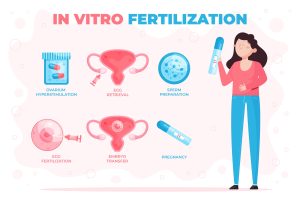In today’s world, the journey to parenthood can be filled with both excitement and challenges. For many, fertility treatments offer hope and options when natural conception proves difficult. Two of the most common treatments are In Vitro Fertilization (IVF) and Intrauterine Insemination (IUI). Understanding these treatments can help you make informed decisions about your reproductive health. Here’s a detailed look at IVF and IUI, including their processes, benefits, and considerations.
In Vitro Fertilization (IVF)
What is IVF?
In Vitro Fertilization (IVF) is a sophisticated and widely used fertility treatment designed to assist individuals and couples in achieving pregnancy when natural conception is challenging or not possible. The term “in vitro” means “in glass,” referring to the process of fertilizing an egg outside the body in a laboratory setting. IVF involves a series of steps aimed at overcoming infertility issues by creating embryos in the lab and then transferring them into the uterus.

The IVF Process
1. Ovarian Stimulation:
The IVF process begins with ovarian stimulation, where hormone medications are administered to encourage the ovaries to produce multiple eggs. Typically, these medications include follicle-stimulating hormone (FSH) and luteinizing hormone (LH). The goal is to increase the number of mature eggs available for retrieval, which enhances the chances of successful fertilization. During this phase, the patient undergoes regular monitoring through ultrasounds and blood tests to track the development of the follicles (egg-containing sacs in the ovaries).
2. Egg Retrieval:
Once the eggs mature, the doctor retrieves them from the ovaries through a minor surgical procedure. The doctor carefully inserts a thin needle through the vaginal wall, guided by ultrasound imaging, to collect the eggs from the ovaries. The doctor typically performs the procedure under sedation or anesthesia to minimize discomfort. They then prepare the retrieved eggs for fertilization.
3. Fertilization:
The doctor combines the retrieved eggs with sperm in a laboratory dish to facilitate fertilization. In standard IVF, doctors mix sperm and eggs together and monitor them for fertilization. When there are issues with sperm quality or quantity, doctors may use a technique called Intracytoplasmic Sperm Injection (ICSI). In ICSI, they inject a single sperm directly into an egg to enhance the chances of fertilization.
4. Embryo Culture:
Once fertilization occurs, the embryologist cultures the resulting embryos in a specialized incubator for several days. During this time, they monitor the embryos to assess their development and quality. Typically, the culture lasts for 3 to 5 days, allowing the embryos to reach the blastocyst stage, which is a crucial point for implantation.
5. Embryo Transfer:
Following embryo culture, one or more of the healthiest embryos are selected for transfer into the uterus. This step is performed using a thin, flexible tube (catheter) that is inserted through the cervix and into the uterus. The transfer is a relatively simple and quick procedure, usually without the need for anesthesia. The goal is to place the embryos in a position where they can implant and grow.
6. Pregnancy Test:
Approximately two weeks after the embryo transfer, a pregnancy test is conducted to determine if the treatment was successful. This test measures levels of human chorionic gonadotropin (hCG), a hormone produced during pregnancy. If the test is positive, further monitoring and ultrasounds are scheduled to confirm the pregnancy and ensure proper development.
Benefits of IVF

1. High Success Rates:
IVF is renowned for its effectiveness, particularly in treating women with specific fertility challenges. The success of IVF largely depends on factors such as the woman’s age, the cause of infertility, and the quality of the eggs and sperm. For many couples, IVF offers a significant chance of conception when other treatments have not worked. Success rates have improved over time due to advancements in technology and techniques, making it a viable option for many seeking to start or expand their families.
2. Flexible Options:
IVF provides flexibility in addressing a range of fertility issues. It allows for the use of donor eggs or sperm, which can be crucial for individuals with compromised reproductive health or genetic concerns. Additionally, IVF offers the option of freezing embryos for future use, which can be beneficial for women who may want to delay pregnancy or have a higher chance of successful implantation. This flexibility helps tailor the treatment to individual needs and circumstances.
3. Overcoming Infertility Issues:
IVF can effectively address various causes of infertility. It is particularly useful in cases where:
- Blocked Fallopian Tubes: IVF bypasses the fallopian tubes by directly fertilizing the eggs in a laboratory setting, which is essential for women with blocked or damaged tubes.
- Male Factor Infertility: For men with low sperm count or motility issues, IVF combined with Intracytoplasmic Sperm Injection (ICSI) can facilitate fertilization by directly injecting sperm into the egg.
- Unexplained Infertility: When the cause of infertility is unknown despite thorough testing, IVF can offer a solution by enabling precise control over the fertilization process.
Considerations
1. Cost:
IVF can be expensive, with costs varying based on factors like location, clinic, and treatment specifics. The price typically includes medication, monitoring, egg retrieval, fertilization, embryo transfer, and follow-up care. Insurance coverage for IVF varies, and many patients may need to pay out-of-pocket. Additionally, multiple cycles may be required to achieve a successful pregnancy, further increasing the cost. Financial planning and exploring potential financial assistance options can be essential when considering IVF.
2. Emotional and Physical Demands:
The IVF process can be physically demanding due to the hormone treatments required to stimulate egg production. These medications can cause side effects such as bloating, mood swings, and fatigue. The procedures involved, including egg retrieval and embryo transfer, may also be uncomfortable or cause temporary discomfort.
Emotionally, IVF can be challenging due to the high stakes and the potential for disappointment if a cycle does not result in pregnancy. The process involves frequent medical appointments, hormonal fluctuations, and the stress of waiting for results. Support from healthcare providers, counseling, and support groups can help manage these emotional demands.
Intrauterine Insemination (IUI)
What is IUI?
Intrauterine Insemination (IUI) is a fertility treatment designed to increase the likelihood of conception by placing sperm directly into the uterus. Unlike more complex procedures like In Vitro Fertilization (IVF), IUI is less invasive and typically involves fewer steps. It aims to enhance the chances of sperm reaching and fertilizing the egg by bypassing some of the barriers that can affect natural conception.

The IUI Process
1. Ovulation Monitoring:
Before the IUI procedure, careful monitoring of ovulation is essential to determine the optimal timing for insemination. Doctors usually use ultrasounds to visualize the development of ovarian follicles or ovulation predictor kits to detect hormonal changes signaling ovulation. Accurate timing ensures that they introduce the sperm into the uterus when an egg is available for fertilization.
2. Sperm Preparation:
A sperm sample is collected from the partner or a sperm donor. In the laboratory, the sperm is processed and prepared to increase its chances of fertilization. This preparation involves concentrating the sperm and removing impurities, dead sperm, and other debris. The goal is to maximize the quality and quantity of sperm that will be used for insemination.
3. Insemination:
The prepared sperm is introduced directly into the uterus using a thin, flexible catheter. This procedure is generally quick and minimally uncomfortable. The catheter is inserted through the cervix and into the uterus, where the sperm is deposited. Unlike more invasive procedures, IUI does not require anesthesia and is typically performed in a doctor’s office or clinic.
4. Pregnancy Test:
About two weeks after the insemination, a pregnancy test is conducted to determine if the procedure was successful. The test measures the levels of human chorionic gonadotropin (hCG), a hormone produced during pregnancy. If the test is positive, further monitoring and follow-up appointments are scheduled to confirm the pregnancy and assess its progress.
Benefits of IUI
1. Less Invasive:
Intrauterine Insemination (IUI) is a less invasive fertility treatment compared to In Vitro Fertilization (IVF). The procedure does not require hormone injections or egg retrieval. Instead, it involves placing prepared sperm directly into the uterus using a thin catheter. This simplicity reduces the physical burden on the patient and avoids the more complex and invasive procedures associated with IVF.
2. Cost-Effective:
IUI is generally more affordable than IVF. The lower cost is partly due to the absence of complex procedures such as egg retrieval and embryo culture. For many individuals and couples, IUI provides a cost-effective initial approach to fertility treatment, making it an attractive option for those who are exploring their options.
3. Quick Recovery:
The IUI procedure is quick and usually performed in a doctor’s office. The actual insemination takes only a few minutes and requires minimal recovery time. Most patients can resume their normal activities immediately after the procedure, making it a convenient option for those with busy schedules or those who prefer a less disruptive treatment.
Considerations

1. Success Rates:
While IUI can be effective, its success rates are generally lower compared to IVF, particularly in cases of severe infertility issues. Success rates for IUI depend on various factors, including the underlying cause of infertility, the age of the woman, and the quality of the sperm. For individuals with significant fertility challenges, IUI may not always result in pregnancy, and alternative or additional treatments may be necessary.
2. Multiple Cycles:
Depending on the reason for infertility and individual response to treatment, multiple IUI cycles may be needed before achieving a successful pregnancy. Each cycle involves monitoring ovulation, preparing the sperm, and performing the insemination procedure. This process can require patience and persistence, as success is not guaranteed with a single attempt.
Choosing Between IVF and IUI
The choice between IVF and IUI depends on several factors, including the underlying cause of infertility, age, and overall health. IVF is often recommended for more complex cases, whereas IUI may be a good starting point for less severe issues or when the cause of infertility is unclear.
Consultation with a Fertility Specialist
Ultimately, a consultation with a fertility specialist is crucial to determine the most appropriate treatment based on individual circumstances. They can provide personalized advice, outline potential treatment plans, and discuss the associated risks and benefits.
Conclusion
Understanding your options for fertility treatments is an essential step in the journey toward parenthood. Both IVF and IUI offer unique advantages and can play a crucial role in overcoming infertility challenges. By consulting with a specialist and exploring these treatments, you can make informed decisions that align with your personal needs and goals.